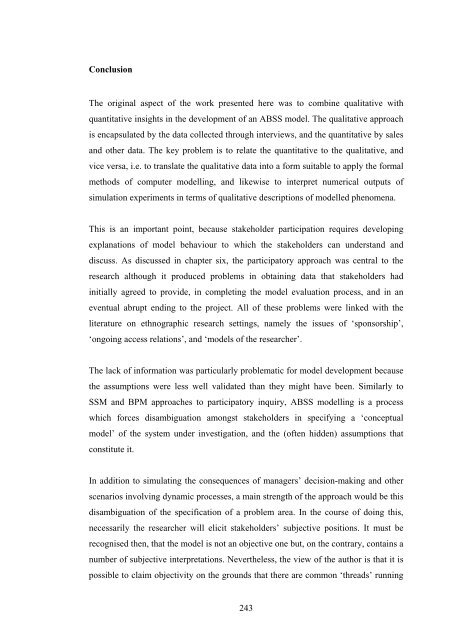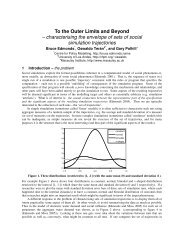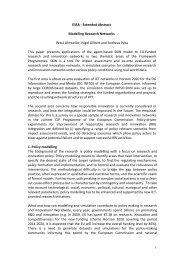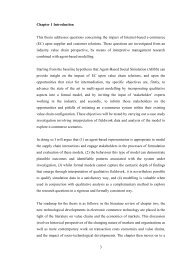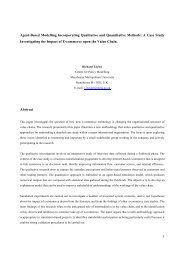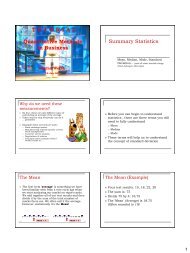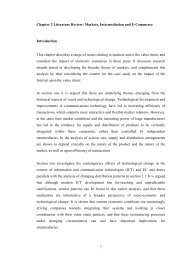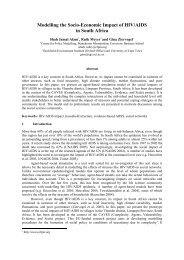222 Chapter 8 Discussion Introduction This chapter reflects on the ...
222 Chapter 8 Discussion Introduction This chapter reflects on the ...
222 Chapter 8 Discussion Introduction This chapter reflects on the ...
You also want an ePaper? Increase the reach of your titles
YUMPU automatically turns print PDFs into web optimized ePapers that Google loves.
C<strong>on</strong>clusi<strong>on</strong><br />
The original aspect of <strong>the</strong> work presented here was to combine qualitative with<br />
quantitative insights in <strong>the</strong> development of an ABSS model. The qualitative approach<br />
is encapsulated by <strong>the</strong> data collected through interviews, and <strong>the</strong> quantitative by sales<br />
and o<strong>the</strong>r data. The key problem is to relate <strong>the</strong> quantitative to <strong>the</strong> qualitative, and<br />
vice versa, i.e. to translate <strong>the</strong> qualitative data into a form suitable to apply <strong>the</strong> formal<br />
methods of computer modelling, and likewise to interpret numerical outputs of<br />
simulati<strong>on</strong> experiments in terms of qualitative descripti<strong>on</strong>s of modelled phenomena.<br />
<str<strong>on</strong>g>This</str<strong>on</strong>g> is an important point, because stakeholder participati<strong>on</strong> requires developing<br />
explanati<strong>on</strong>s of model behaviour to which <strong>the</strong> stakeholders can understand and<br />
discuss. As discussed in <str<strong>on</strong>g>chapter</str<strong>on</strong>g> six, <strong>the</strong> participatory approach was central to <strong>the</strong><br />
research although it produced problems in obtaining data that stakeholders had<br />
initially agreed to provide, in completing <strong>the</strong> model evaluati<strong>on</strong> process, and in an<br />
eventual abrupt ending to <strong>the</strong> project. All of <strong>the</strong>se problems were linked with <strong>the</strong><br />
literature <strong>on</strong> ethnographic research settings, namely <strong>the</strong> issues of ‘sp<strong>on</strong>sorship’,<br />
‘<strong>on</strong>going access relati<strong>on</strong>s’, and ‘models of <strong>the</strong> researcher’.<br />
The lack of informati<strong>on</strong> was particularly problematic for model development because<br />
<strong>the</strong> assumpti<strong>on</strong>s were less well validated than <strong>the</strong>y might have been. Similarly to<br />
SSM and BPM approaches to participatory inquiry, ABSS modelling is a process<br />
which forces disambiguati<strong>on</strong> am<strong>on</strong>gst stakeholders in specifying a ‘c<strong>on</strong>ceptual<br />
model’ of <strong>the</strong> system under investigati<strong>on</strong>, and <strong>the</strong> (often hidden) assumpti<strong>on</strong>s that<br />
c<strong>on</strong>stitute it.<br />
In additi<strong>on</strong> to simulating <strong>the</strong> c<strong>on</strong>sequences of managers’ decisi<strong>on</strong>-making and o<strong>the</strong>r<br />
scenarios involving dynamic processes, a main strength of <strong>the</strong> approach would be this<br />
disambiguati<strong>on</strong> of <strong>the</strong> specificati<strong>on</strong> of a problem area. In <strong>the</strong> course of doing this,<br />
necessarily <strong>the</strong> researcher will elicit stakeholders’ subjective positi<strong>on</strong>s. It must be<br />
recognised <strong>the</strong>n, that <strong>the</strong> model is not an objective <strong>on</strong>e but, <strong>on</strong> <strong>the</strong> c<strong>on</strong>trary, c<strong>on</strong>tains a<br />
number of subjective interpretati<strong>on</strong>s. Never<strong>the</strong>less, <strong>the</strong> view of <strong>the</strong> author is that it is<br />
possible to claim objectivity <strong>on</strong> <strong>the</strong> grounds that <strong>the</strong>re are comm<strong>on</strong> ‘threads’ running<br />
243


